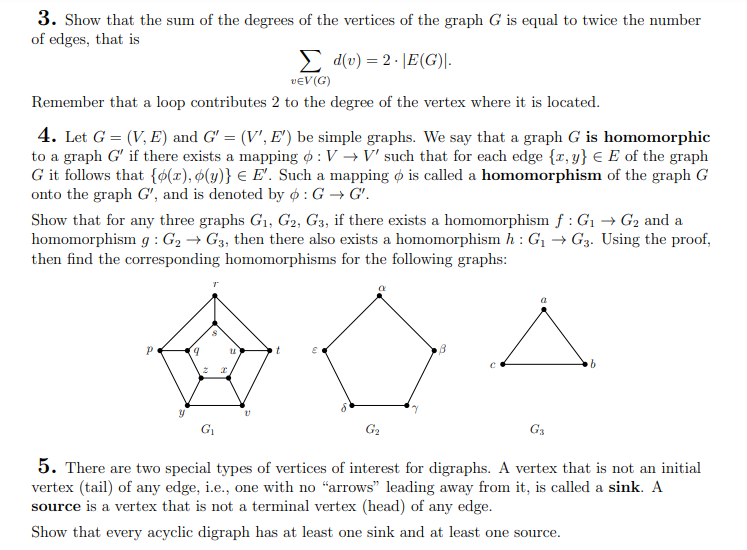3. Show that the sum of the degrees of the vertices of the graph G is equal to twice the number of edges, that is Σd(v) = 2-|E(G)|. VEV (G) Remember that a loop contributes 2 to the degree of the vertex where it is located.
3. Show that the sum of the degrees of the vertices of the graph G is equal to twice the number of edges, that is Σd(v) = 2-|E(G)|. VEV (G) Remember that a loop contributes 2 to the degree of the vertex where it is located.
College Algebra (MindTap Course List)
12th Edition
ISBN:9781305652231
Author:R. David Gustafson, Jeff Hughes
Publisher:R. David Gustafson, Jeff Hughes
Chapter5: Exponential And Logarithmic Functions
Section5.3: Logarithmic Functions And Their Graphs
Problem 137E
Related questions
Question

Transcribed Image Text:3. Show that the sum of the degrees of the vertices of the graph G is equal to twice the number
of edges, that is
Σd(v) = 2. |E(G).
VEV (G)
Remember that a loop contributes 2 to the degree of the vertex where it is located.
4. Let G = (V, E) and G' = (V', E') be simple graphs. We say that a graph G is homomorphic
to a graph G' if there exists a mapping ø: V → V' such that for each edge {x,y} E of the graph
G it follows that {o(r), (y)} = E'. Such a mapping o is called a homomorphism of the graph G
onto the graph G', and is denoted by : G → G'.
Show that for any three graphs G₁, G2, G3, if there exists a homomorphism f: G₁ → G₂ and a
homomorphism g: G₂ → G3, then there also exists a homomorphism h : G₁ → G3. Using the proof,
then find the corresponding homomorphisms for the following graphs:
P
y
9
G₁
"1
21
t
Q
9
C
G3
b
G₂
5. There are two special types of vertices of interest for digraphs. A vertex that is not an initial
vertex (tail) of any edge, i.e., one with no "arrows" leading away from it, is called a sink. A
source is a vertex that is not a terminal vertex (head) of any edge.
Show that every acyclic digraph has at least one sink and at least one source.
Expert Solution
This question has been solved!
Explore an expertly crafted, step-by-step solution for a thorough understanding of key concepts.
This is a popular solution!
Trending now
This is a popular solution!
Step by step
Solved in 4 steps

Recommended textbooks for you

College Algebra (MindTap Course List)
Algebra
ISBN:
9781305652231
Author:
R. David Gustafson, Jeff Hughes
Publisher:
Cengage Learning

College Algebra (MindTap Course List)
Algebra
ISBN:
9781305652231
Author:
R. David Gustafson, Jeff Hughes
Publisher:
Cengage Learning